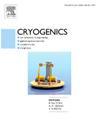含缺陷液氦冷却三带REBCO电缆电流共流仿真研究:有效电导率、导热系数及热边界条件的影响
IF 2.1
3区 工程技术
Q3 PHYSICS, APPLIED
引用次数: 0
摘要
电流共享是由REBCO涂层导体制成的无绝缘线圈和多股电缆的关键自我保护机制。通常,对电流共享至关重要的主要变量是股间电阻,超导导线或胶带之间的表面接触电阻通常起着重要作用。然而,对于低温超导体制成的电缆来说,热传导也是一个重要的因素,尽管是次要的因素。在这项工作中,我们证明了热变量对REBCO中电流共享的重要性,包括电缆内的有效热导率和电缆的热边界条件。本文采用有限元方法(FEM)对三层含缺陷的REBCO电缆的电流共享行为进行了建模,其中缺陷密度设置为每3厘米电缆中有一个缺陷。电流共享度量(CSM)定义为热失控前可达到的电流(Ia)与电缆标称临界电流(Ic)的比值。我们的模拟表明,CSM (Ia/Ic)随着链间接触电阻的降低而增加,包括链间电接触电阻(ICR)和链间热接触电阻(ITR)。然后,我们分析了两种不同初始状态下的电流分担:平衡和暂态。在平衡状态下,电缆在激励之前就存在缺陷,这可能是由于电缆形成或磁铁绕组过程中底层导体的不均匀性或缺陷引起的。在这种情况下,电流沿电缆均匀分布。在暂态下,缺陷是在使用过程中形成的,即当缺陷产生时,电缆已经在承载其工作电流。在这里,电流共享被限制在缺陷区域附近的一个区域,与给予相同的链间接触特性的平衡状态相比,导致更低的CSM。最后,我们探讨了一系列具有不同ICR和ITR集的特定情况下平衡状态下的电流共享。通过对40种不同情况的模拟,我们开发了一个描述电流共享与链间接触特性之间相关性的解析表达式,为理解REBCO电缆中的电流共享行为提供了一个预测框架。本文章由计算机程序翻译,如有差异,请以英文原文为准。
Simulation study of current sharing in a liquid Helium-cooled three-tape REBCO cable with defects: influence of effective electrical and thermal conductivities and thermal boundary conditions
Current sharing is a critical self-protecting mechanism for no-insulation coils and multi-strand cables made from REBCO coated conductors. Typically, the primary variable considered vital for current sharing is the inter-strand resistance, with surface contact resistance between superconducting wires or tapes often making a significant contribution. However, thermal conductance is also known to be an important, albeit secondary, factor for cables made from low-temperature superconductors. In this work, we demonstrate that the importance of thermal variables is even greater for current sharing in REBCO, including the effective thermal conductance within the cable and the cable’s thermal boundary condition.
We focus on finite element method (FEM) modeling of current sharing behavior in a three-layer REBCO cable with defects, where the defect density is set at one defect per 3 cm of cable. A current sharing metric (CSM) is defined as the ratio of achievable current (Ia) before thermal runaway occurs to the cable’s nominal critical current (Ic). Our simulations indicate that the CSM (Ia/Ic) increases with decreasing inter-strand contact resistance, encompassing both inter-strand electrical contact resistance (ICR) and inter-strand thermal contact resistance (ITR). We then analyze current sharing in two different initial states: equilibrium and transient. In the equilibrium state, the cable has pre-existing defects before excitation, potentially due to underlying conductor inhomogeneities or defects induced during cable formation or magnet winding. In this case, current sharing is well-distributed along the cable. In the transient state, the defect forms during service — that is, the cable is already carrying its operating current when the defect arises. Here, current sharing is limited to a region near the defective area, resulting in a lower CSM compared to the equilibrium state given the same inter-strand contact properties. Finally, we explored current sharing in the equilibrium state across a series of specific cases with varying sets of ICR and ITR. Through simulations of 40 different cases, we developed an analytic expression describing the correlation between current sharing and the inter-strand contact properties, providing a predictive framework for understanding current sharing behavior in REBCO cables.
求助全文
通过发布文献求助,成功后即可免费获取论文全文。
去求助
来源期刊

Cryogenics
物理-热力学
CiteScore
3.80
自引率
9.50%
发文量
0
审稿时长
2.1 months
期刊介绍:
Cryogenics is the world''s leading journal focusing on all aspects of cryoengineering and cryogenics. Papers published in Cryogenics cover a wide variety of subjects in low temperature engineering and research. Among the areas covered are:
- Applications of superconductivity: magnets, electronics, devices
- Superconductors and their properties
- Properties of materials: metals, alloys, composites, polymers, insulations
- New applications of cryogenic technology to processes, devices, machinery
- Refrigeration and liquefaction technology
- Thermodynamics
- Fluid properties and fluid mechanics
- Heat transfer
- Thermometry and measurement science
- Cryogenics in medicine
- Cryoelectronics
 求助内容:
求助内容: 应助结果提醒方式:
应助结果提醒方式:


